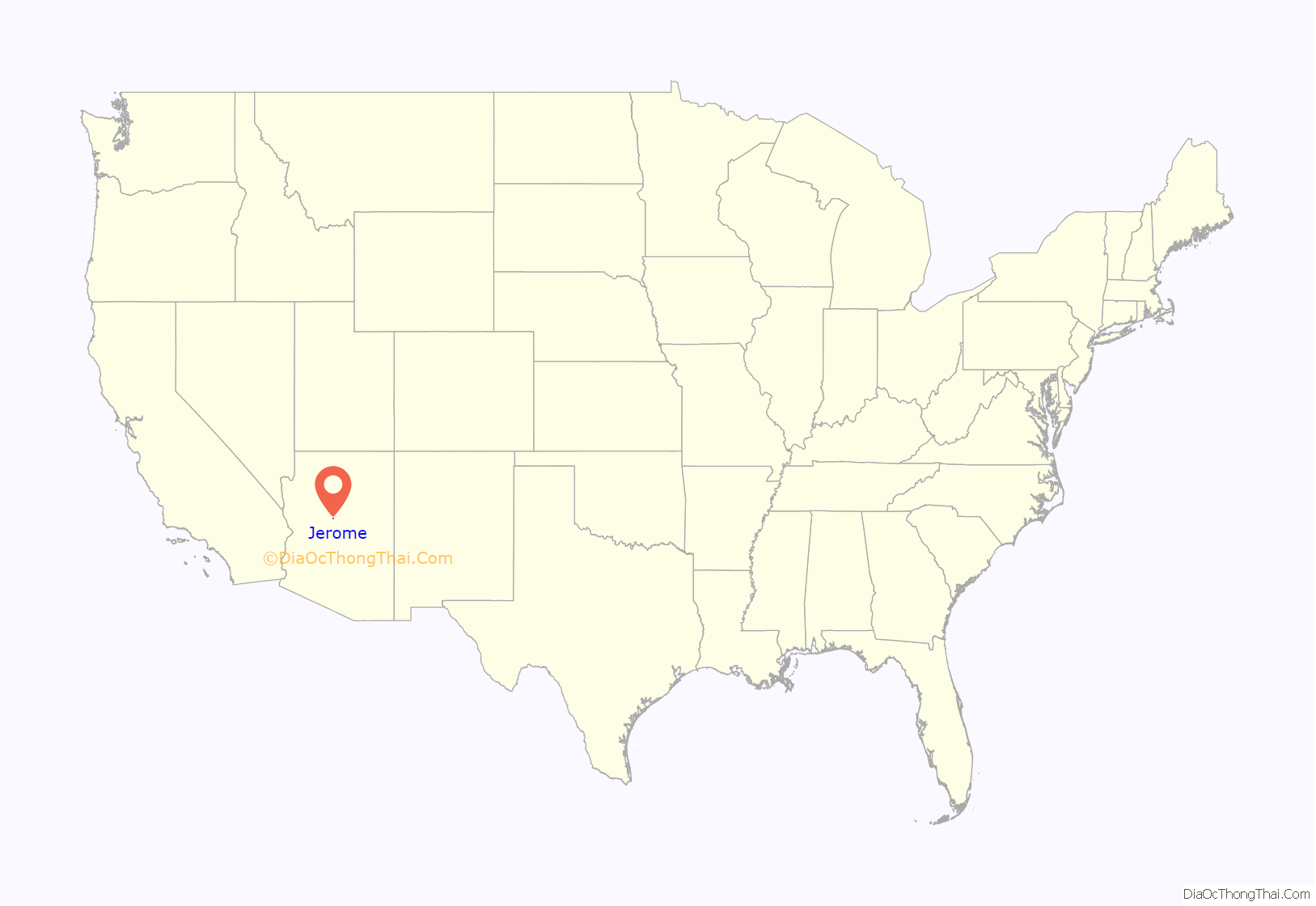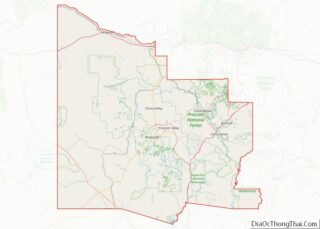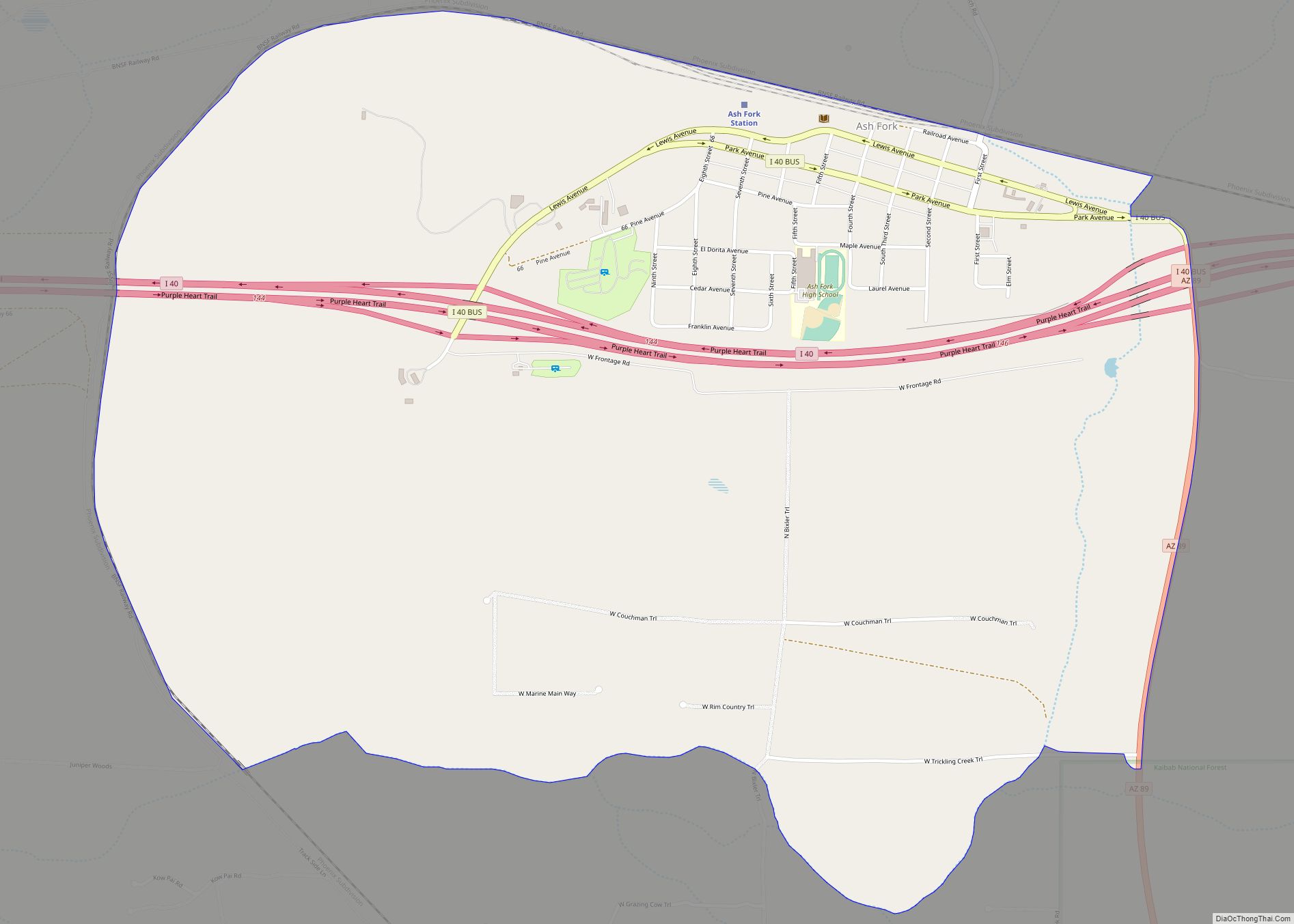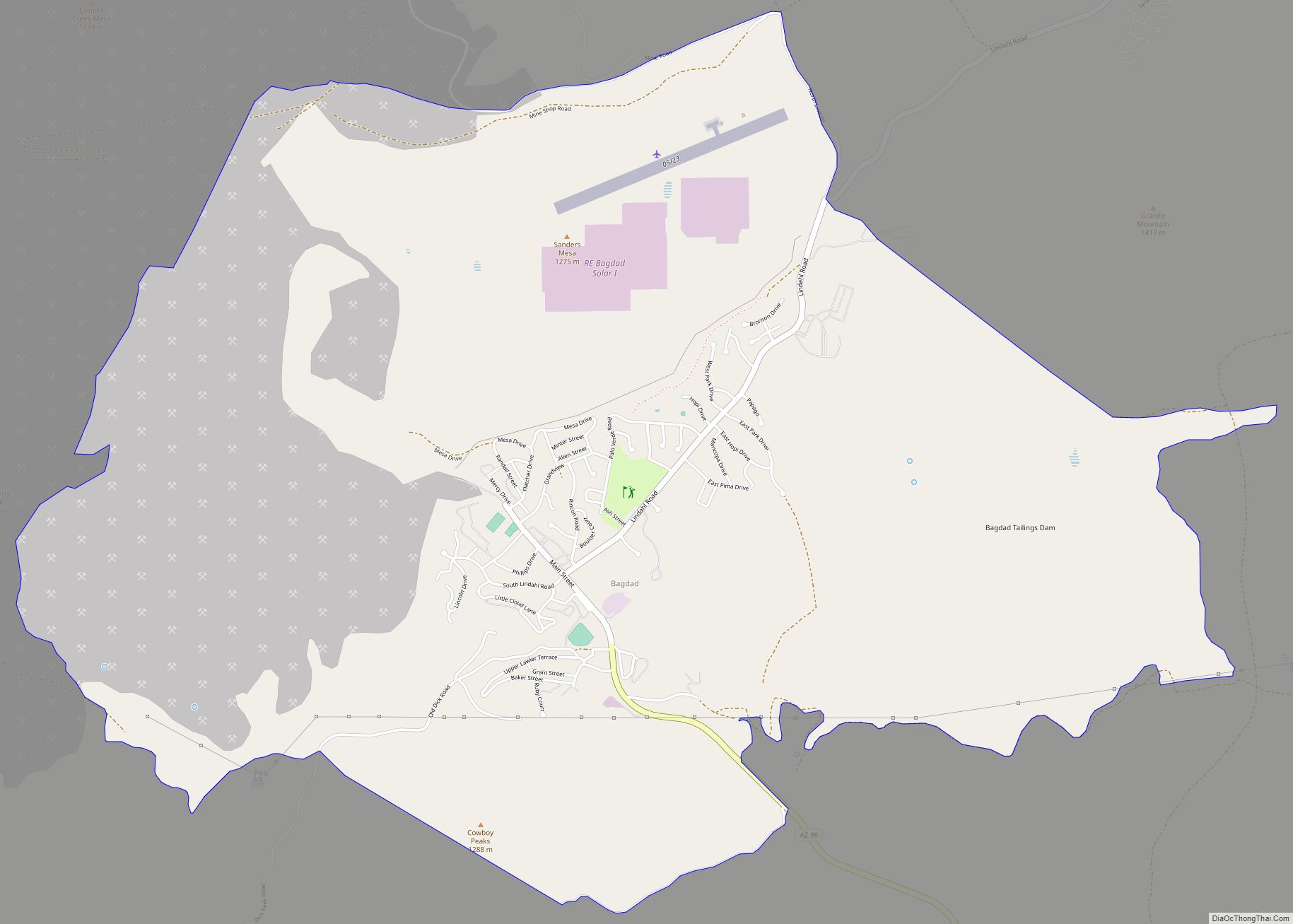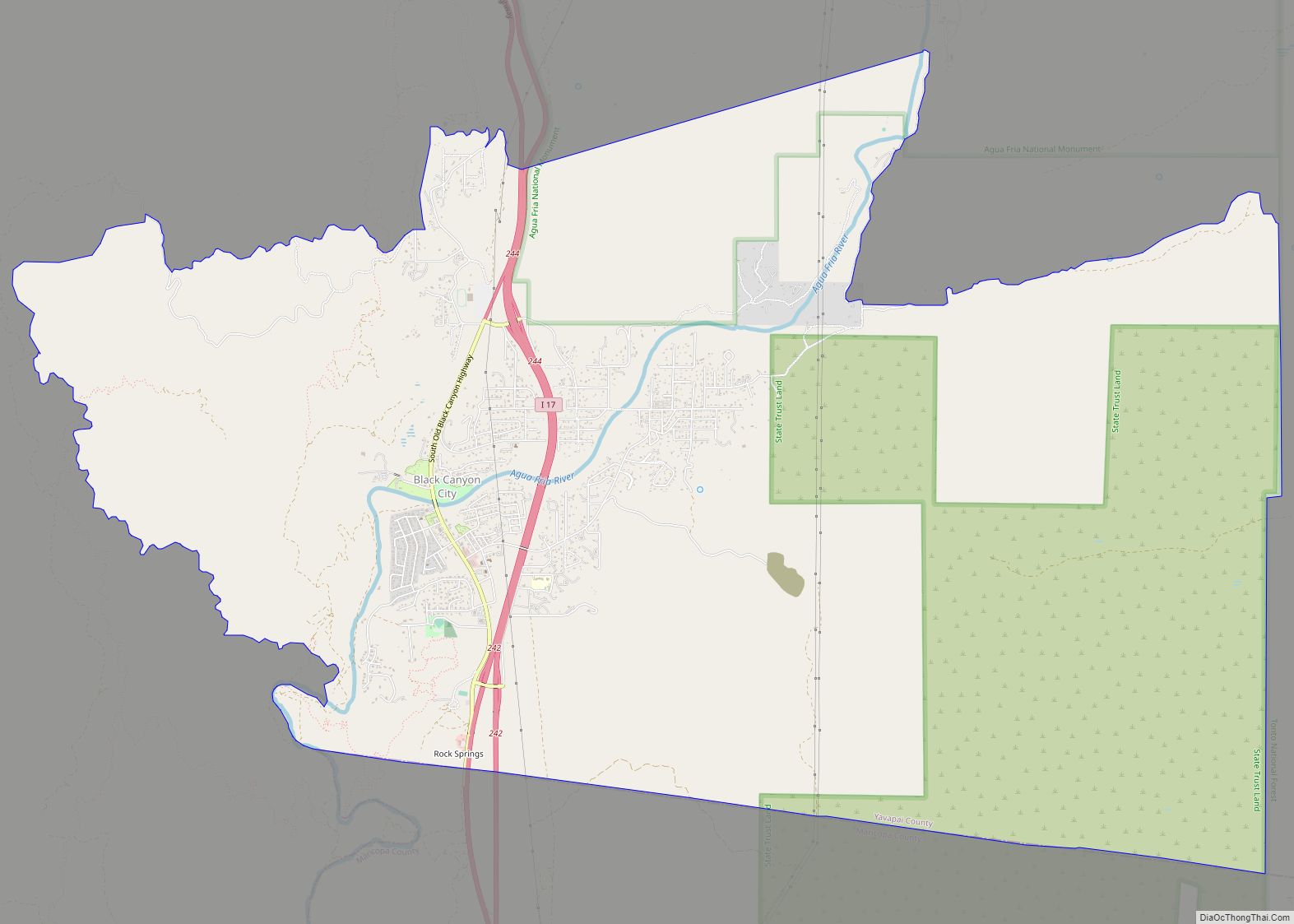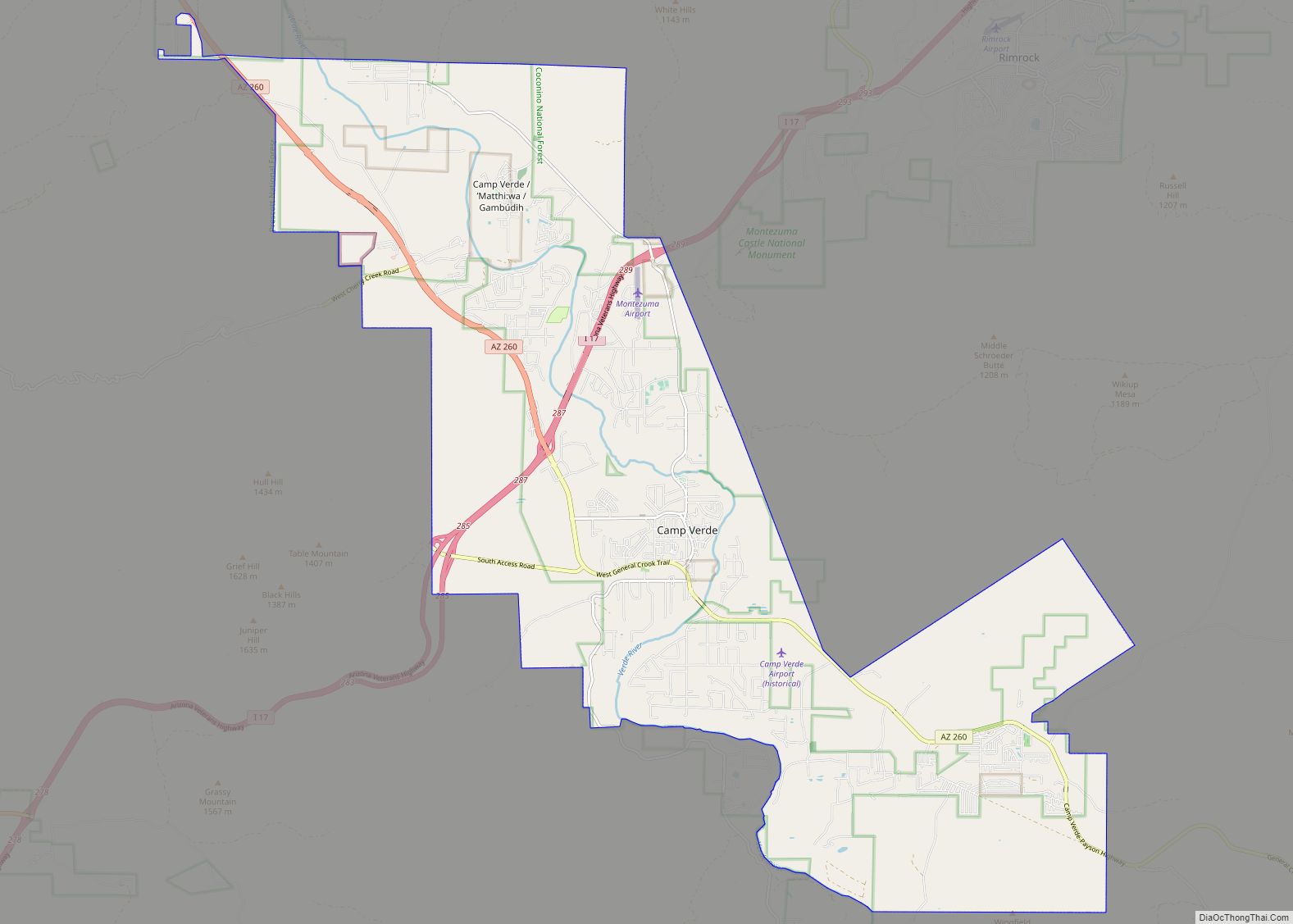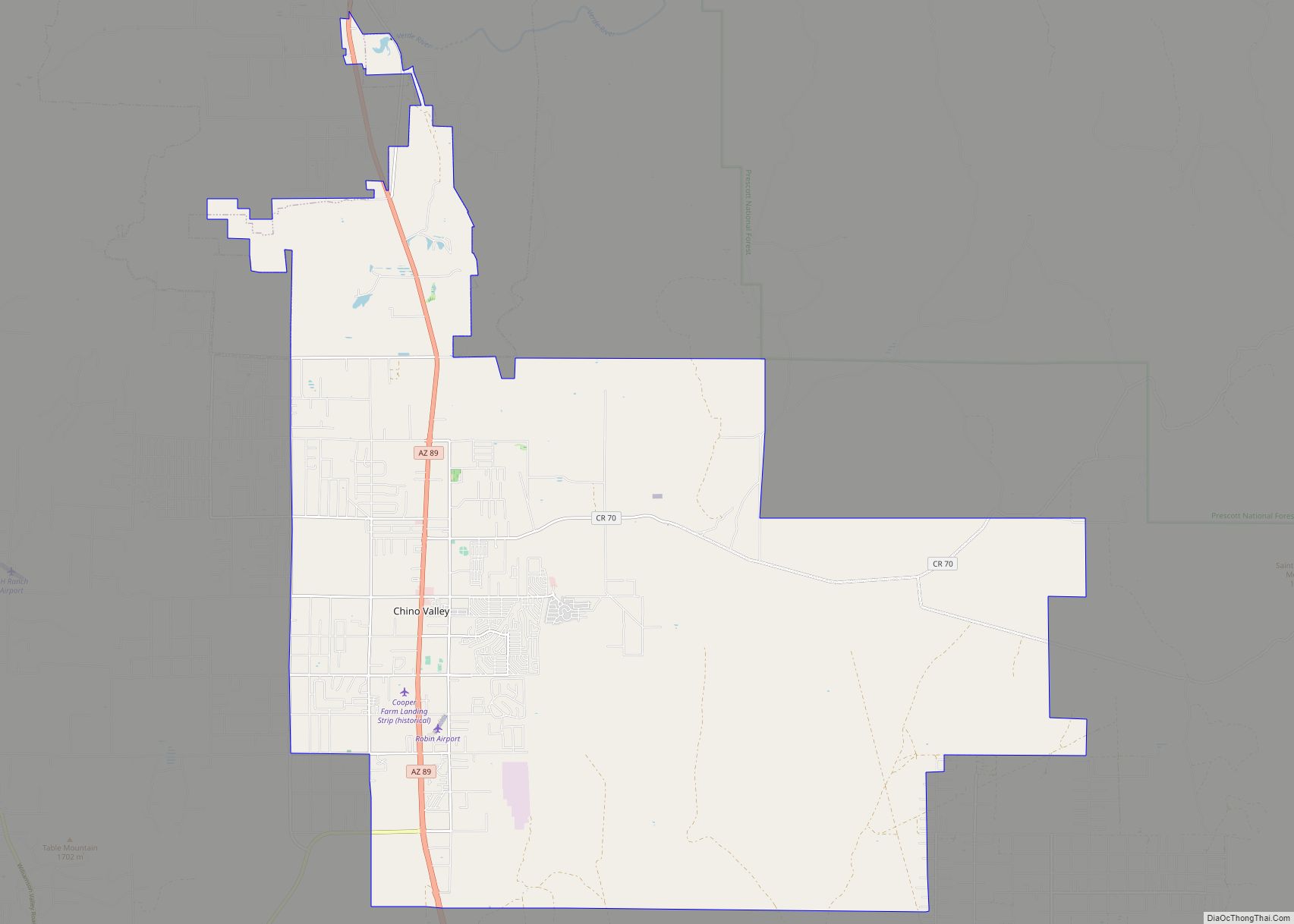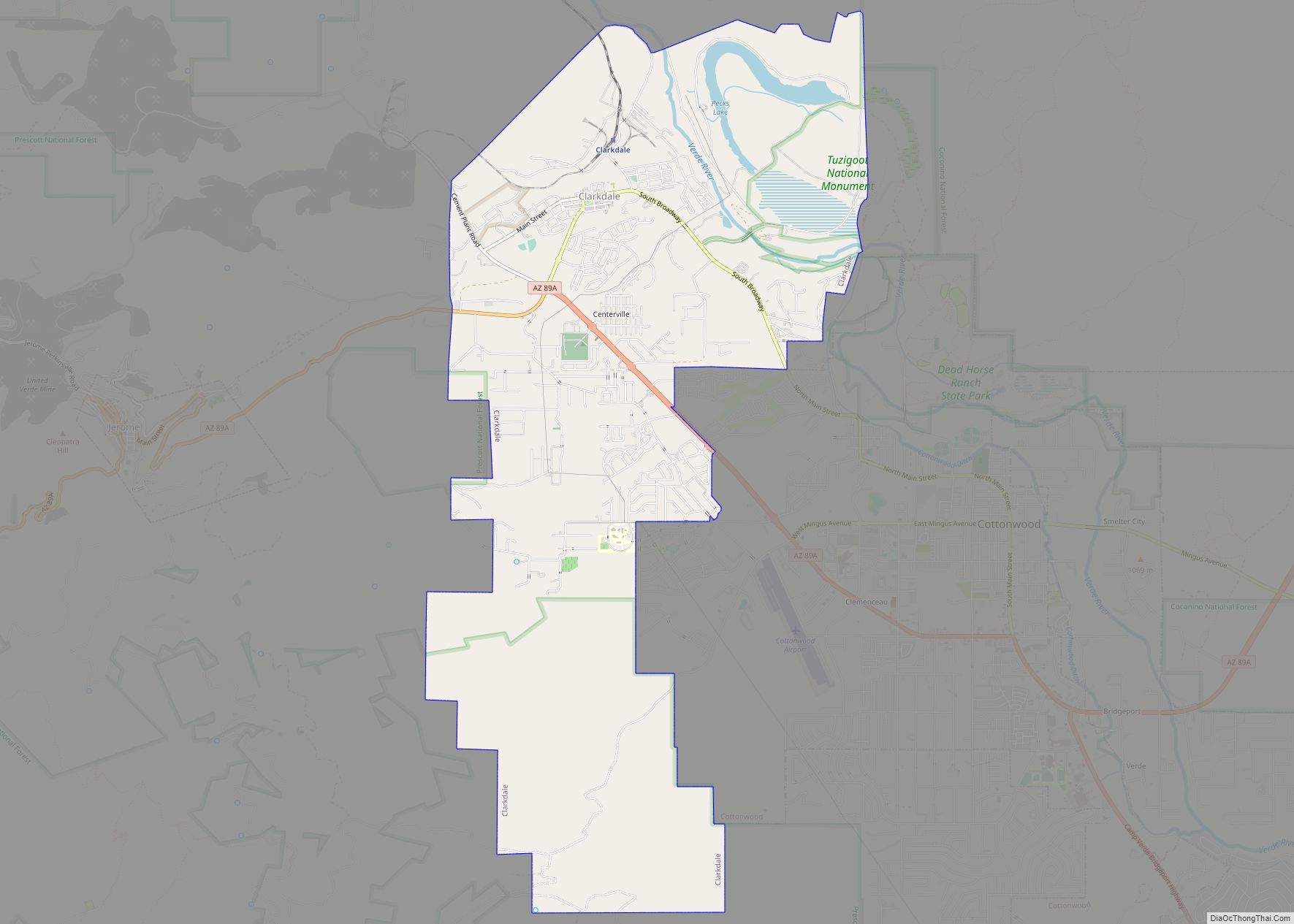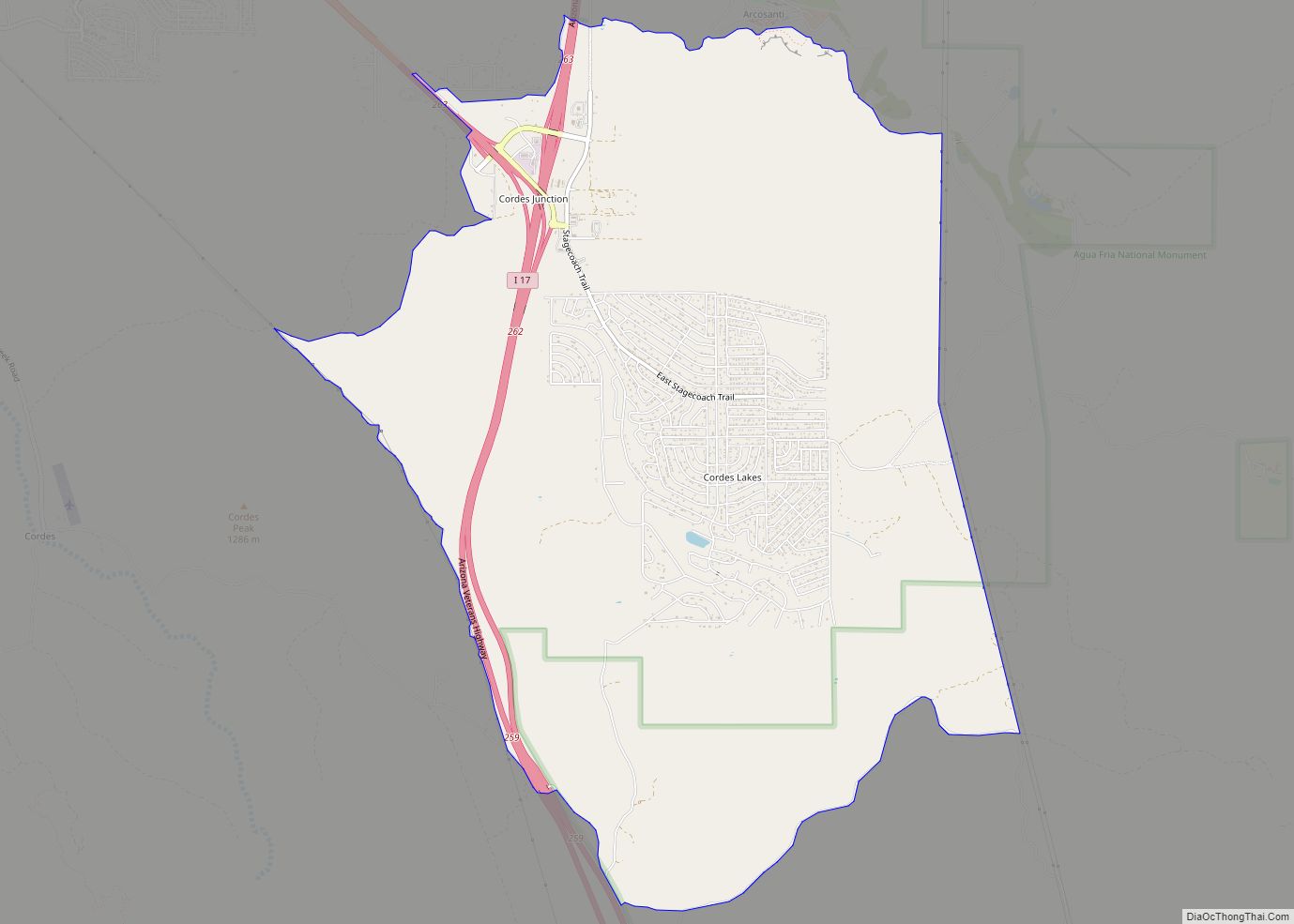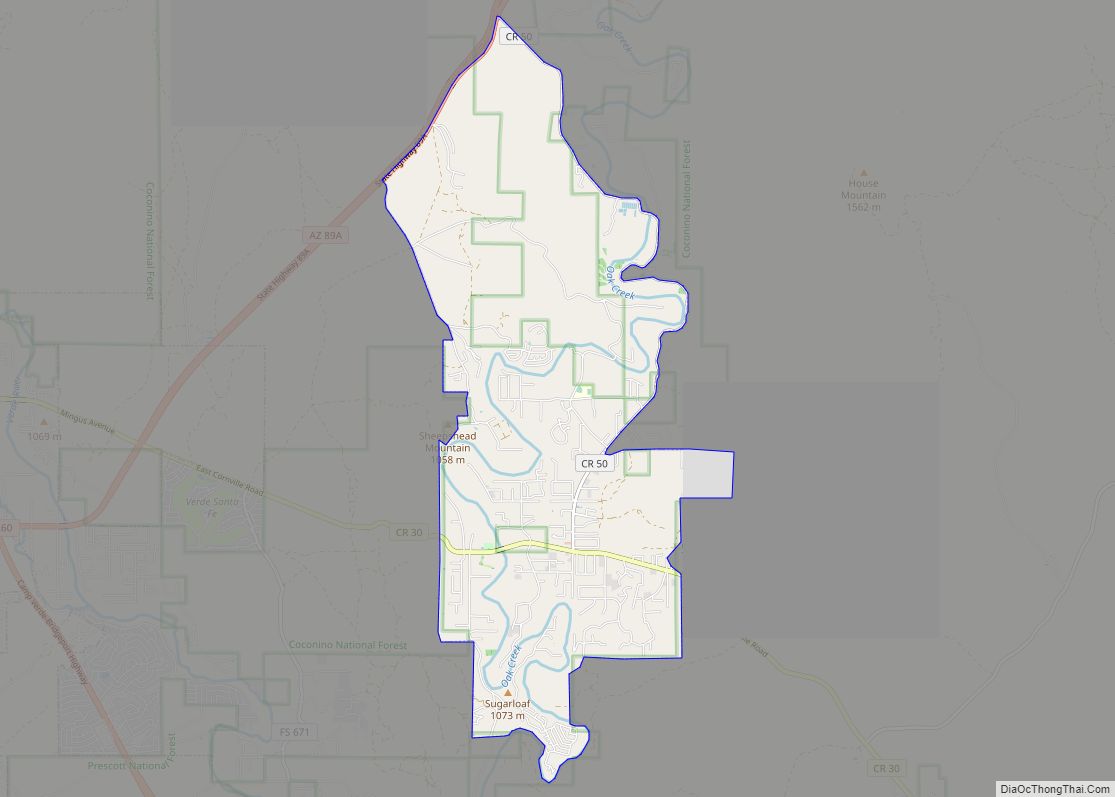Jerome is a town in the Black Hills of Yavapai County in the U.S. state of Arizona. Founded in the late 19th century on Cleopatra Hill overlooking the Verde Valley, Jerome is located more than 5,000 feet (1,500 m) above sea level. It is about 100 miles (160 km) north of Phoenix along State Route 89A between Sedona and Prescott. Supported in its heyday by rich copper mines, it was home to more than 10,000 people in the 1920s. As of the 2010 census, its population was 444. It is now known for its tourist attractions, such as its “ghost town” status and local wineries.
The town owes its existence mainly to two ore bodies that formed about 1.75 billion years ago along a ring fault in the caldera of an undersea volcano. Tectonic plate movements, plate collisions, uplift, deposition, erosion, and other geologic processes eventually exposed the tip of one of the ore bodies and pushed the other close to the surface, both near Jerome. In the late 19th century, the United Verde Mine, developed by William A. Clark, extracted ore bearing copper, gold, silver, and other metals from the larger of the two. The United Verde Extension UVX Mine, owned by James Douglas Jr., depended on the other huge deposit. In total, the copper deposits discovered in the vicinity of Jerome were among the richest ever found.
Jerome made news in 1917 when labor unrest involving the Industrial Workers of the World (IWW) led to the expulsion at gunpoint of about 60 IWW members, who were loaded on a cattle car and shipped west. Production at the mines, always subject to fluctuations, boomed during World War I, fell thereafter, rose again, then fell again during and after the Great Depression. As the ore deposits ran out, the mines closed for good in 1953, and the population dwindled to fewer than 100. Efforts to save the town from oblivion succeeded when residents turned to tourism and retail sales. Jerome became a National Historic Landmark in 1967. By the early 21st century, Jerome had art galleries, coffee houses, restaurants, a state park, and a local museum devoted to mining history.
| Name: | Jerome town |
|---|---|
| LSAD Code: | 43 |
| LSAD Description: | town (suffix) |
| State: | Arizona |
| County: | Yavapai County |
| Incorporated: | 1899 |
| Elevation: | 5,066 ft (1,544 m) |
| Total Area: | 0.79 sq mi (2.04 km²) |
| Land Area: | 0.79 sq mi (2.04 km²) |
| Water Area: | 0.00 sq mi (0.00 km²) |
| Total Population: | 464 |
| Population Density: | 590.33/sq mi (227.90/km²) |
| ZIP code: | 86331 |
| Area code: | 928 |
| FIPS code: | 0436290 |
| GNISfeature ID: | 30522 |
Online Interactive Map
Click on ![]() to view map in "full screen" mode.
to view map in "full screen" mode.
Jerome location map. Where is Jerome town?
History
Early
The Hohokam were the first people known to have lived and farmed near Jerome from 700 to 1125 CE. Later, long before the arrival of Europeans, it is likely that other native peoples mined the United Verde ore body for the colorful copper-bearing minerals malachite and azurite. The top of the ore body was accessible because it was visible on the surface.
The first Europeans to arrive in the area were the Spanish conquistadors. At the time the area was part of “New Mexico”, and the Spaniards often organized silver and gold prospecting expeditions in the area. In 1585, Spanish explorers made note of the ore but did not mine it because their government had sent them to find gold and silver, not copper.
19th century
The area became part of Mexico when Mexico gained its independence from Spain in 1821, and part of the United States by terms of the 1848 Treaty of Guadalupe Hidalgo, which concluded the Mexican–American War. The war’s major consequence was the Mexican Cession of the northern territories of Alta California and Santa Fe de Nuevo México to the United States.
Angus McKinnon and Morris A. Ruffner filed the first copper mining claims at this location in 1876. In 1880, Frederick A. Tritle, the governor of the Arizona Territory, and Frederick F. Thomas, a mining engineer from San Francisco, bought these claims from the original owners. In 1883, with the aid of eastern financiers including James A. MacDonald and Eugene Jerome of New York City, they created the United Verde Copper Company. The small adjacent mining camp on Cleopatra Hill was named Jerome in honor of Eugene Jerome, who became the company secretary. United Verde built a small smelter at Jerome and constructed wagon roads from it to Prescott, the Verde Valley, and the Atlantic and Pacific Railroad depot at Ash Fork. However, transport by wagon was expensive, and in late 1884 after the price of copper had fallen by 50 percent, the company ceased all operations at the site.
Four years later, William A. Clark, who had made a fortune in mining and commercial ventures in Montana, bought the United Verde properties and, among other improvements, enlarged the smelter. He ordered construction of a narrow gauge railway, the United Verde & Pacific, to Jerome Junction, a railway transfer point 27 miles (43 km) to the west. As mining of the ore expanded, Jerome’s population grew from 250 in 1890 to more than 2,500 by 1900. By then the United Verde Mine had become the leading copper producer in the Arizona Territory, employing about 800 men, and was one of the largest mines in the world. Over its 77-year life (1876 to 1953), this mine produced nearly 33 million tons of copper, gold, silver, lead and zinc ore. The metals produced by United Verde and UVX, the other big mine in Jerome, were said to be worth more than $1 billion. According to geologists Lon Abbott and Terri Cook, the combined copper deposits of Jerome were among the richest ever found.
Jerome had a post office by 1883. It added a schoolhouse in 1884 and a public library in 1889. After four major fires between 1894 and 1898 destroyed much of the business district and half of the community’s homes, Jerome was incorporated as a town in 1899. Incorporation made it possible to collect taxes to build a formal fire-fighting system and to establish building codes that prohibited tents and other fire hazards within the town limits. Local merchant and rancher William Munds was the first mayor.
By 1900, Jerome had churches, fraternal organizations, and a downtown with brick buildings, telephone service, and electric lights. Among the thriving businesses were those associated with alcohol, gambling, and prostitution serving a population that was 78 percent male. In 1903, New York’s The Sun proclaimed Jerome “the wickedest town in the West”.
Early 20th century
Jerome, which was legally separate from United Verde and supported many independent businesses, did not meet the definition of a company town even though it depended for decades largely on a single company. In 1914, a separate company, the United Verde Extension Mining Company (UVX), led by James S. Douglas, Jr. (nicknamed Rawhide Jimmy), discovered a second ore body near Jerome that produced a bonanza. The UVX Mine, also known as the Little Daisy Mine, became spectacularly profitable: during 1916 alone, it produced $10 million worth of copper, silver and gold, of which $7.4 million was profit. This mine eventually produced more than $125 million worth of ore and paid more than $50 million in dividends. Total production amounted to four million tons, much less than the United Verde total but from uncommonly rich ore averaging more than 10 percent copper and in places rising to 45 percent.
Starting in 1914, World War I greatly increased the demand for copper, and by 1916 the number of companies involved in mining near Jerome reached 22. These companies employed about 3,000 miners in the district. Meanwhile, United Verde was building a large smelter complex and company town, Clarkdale, and a standard gauge railway, the Verde Tunnel and Smelter Railroad, to haul ore from its mine to the new smelter. After the new railway opened in 1915, the company dismantled the Jerome smelter and converted the mine to an open-pit operation by 1919. The switch from underground to open-pit mining stemmed from a series of fires, some burning for decades, in the mine’s high-sulfur ores. Removing the overburden and pouring a mixture of water, waste ore, and sand into rock fissures helped control the fires. By 1918, UVX also had its own smelter in its own company town near Cottonwood; the company town was named Clemenceau in 1920. In 1929, a company named Verde Central opened what at first appeared to be another “great mine” about a mile southwest of Jerome.
The labor situation in Jerome was complicated. Three separate labor unions—the International Union of Mine, Mill, and Smelter Workers (MMSW), the Industrial Workers of the World or IWW, and the Liga Protectora Latina, which represented about 500 Mexican miners—had members in Jerome. In 1917, two miners’ strikes involving the IWW, which had been organizing strikes elsewhere in Arizona and other states, took place in Jerome. Seen as a threat by business interests as well as other labor unions, the Wobblies, as they were called, were subject nationally to sometimes violent harassment. The MMSW, which in May called a strike against United Verde, regarded the rival IWW with animosity and would not recognize it as legitimate. In response, the IWW members threatened to break the strike. Under pressure, the MMSW voted 467 to 431 to settle for less than they wanted.
In July, the IWW called for a strike against all the mines in the district. In this case, the MMSW voted 470 to 194 against striking. Three days later, about 250 armed vigilantes rounded up at least 60 suspected IWW members, loaded them onto a railroad cattle car, and shipped them out of town in what has been called the Jerome Deportation. Nine IWW members, thought by the Prescott sheriff’s department to be leaders, were arrested and jailed temporarily in Prescott though never charged with a crime; others were taken to Needles, California, then to Kingman, Arizona, where they were released after promising to desist from “further agitation”.
After 1920
Following a brief post-war downturn, boom times returned to Jerome in the 1920s. Copper prices rose to 24 cents a pound in 1929, and United Verde and UVX operated at near capacity. Wages rose, consumers spent, and the town’s businesses—including five automobile dealerships—prospered. United Verde, seeking stable labor relations, added disability and life insurance benefits for its workers and built a baseball field, tennis courts, swimming pools, and a public park in Jerome. Both companies donated to the Jerome Public Library and helped finance projects for the town’s schools, churches, and hospitals.
In 1930, after the start of the Great Depression, the price of copper fell to 14 cents a pound. In response, United Verde began reducing its work force; UVX operated at a loss, and the third big mine, Verde Central, closed completely. The price of copper fell further in 1932 to 5 cents a pound, leading to layoffs, temporary shut-downs, and wage reductions in the Verde District. In 1935, the Clark family sold United Verde to Phelps Dodge, and in 1938 UVX went out of business.
Meanwhile, a subsidence problem that had irreparably damaged at least 10 downtown buildings by 1928 worsened through the 1930s. Dozens of buildings, including the post office and jail, were lost as the earth beneath them sank away. Contributing causes were geologic faulting in the area, blast vibrations from the mines, and erosion that may have been exacerbated by vegetation-killing smelter smoke.
Mining continued at a reduced level in the Verde District until 1953, when Phelps Dodge shut down the United Verde Mine and related operations. Jerome’s population subsequently fell below 100. To prevent the town from disappearing completely, its remaining residents turned to tourism and retail sales. They organized the Jerome Historical Society in 1953 and opened a museum and gift shop.
To encourage tourism, the town’s leaders sought National Historic Landmark status for Jerome; it was granted by the federal government in 1967. In 1962, the heirs of James Douglas donated the Douglas mansion, above the UVX mine site, to the State of Arizona, which used it to create Jerome State Historic Park. By sponsoring music festivals, historic-homes tours, celebrations, and races, the community succeeded in attracting visitors and new businesses, which in the 21st century include art galleries, craft stores, wineries, coffee houses, and restaurants.
Jerome Road Map
Jerome city Satellite Map
Geography
Jerome is about 100 miles (160 km) north of Phoenix and 45 miles (72 km) southwest of Flagstaff along Arizona State Route 89A between Sedona to the east and Prescott to the west. The town is in Arizona’s Black Hills, which trend north–south. The town lies within the Prescott National Forest at an elevation of more than 5,000 feet (1,500 m). Woodchute Wilderness is about 3 miles (5 km) west of Jerome, and Mingus Mountain, at 7,726 feet (2,355 m) above sea level, is about 4 miles (6 km) south of town. Jerome State Historic Park is in the town itself. Bitter Creek, a tributary of the Verde River, flows intermittently through Jerome. East of Jerome at the base of the hills are the Verde Valley and the communities of Clarkdale and Cottonwood, site of the nearest airport.
See also
Map of Arizona State and its subdivision: Map of other states:- Alabama
- Alaska
- Arizona
- Arkansas
- California
- Colorado
- Connecticut
- Delaware
- District of Columbia
- Florida
- Georgia
- Hawaii
- Idaho
- Illinois
- Indiana
- Iowa
- Kansas
- Kentucky
- Louisiana
- Maine
- Maryland
- Massachusetts
- Michigan
- Minnesota
- Mississippi
- Missouri
- Montana
- Nebraska
- Nevada
- New Hampshire
- New Jersey
- New Mexico
- New York
- North Carolina
- North Dakota
- Ohio
- Oklahoma
- Oregon
- Pennsylvania
- Rhode Island
- South Carolina
- South Dakota
- Tennessee
- Texas
- Utah
- Vermont
- Virginia
- Washington
- West Virginia
- Wisconsin
- Wyoming
